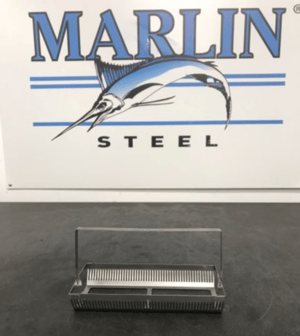 One of the major challenges in washing parts with a “no-scratch” surface requirement in an ultrasonic parts cleaning machine is that the rapid vibration of the cleaning process can cause parts to scratch with ease. So, many manufacturers use dividers and baskets with soft coatings to minimize the contact between parts and the baskets that hold them.
One of the major challenges in washing parts with a “no-scratch” surface requirement in an ultrasonic parts cleaning machine is that the rapid vibration of the cleaning process can cause parts to scratch with ease. So, many manufacturers use dividers and baskets with soft coatings to minimize the contact between parts and the baskets that hold them.
However, adding a thick, soft coating material can have another consequence—it minimizes the effectiveness of the ultrasonic cavitation process used to break up contaminants and get parts cleaned. This is the problem that a recent Marlin Steel client had with their old parts washing baskets. The thick niloxy coating they were using kept the baskets from causing damage to their parts, but each basket would have to be put through the ultrasonic cleaning process multiple times to achieve the level of clean they needed to consider the part ready for final assembly.
To solve this challenge, the client decided to consult with Marlin Steel to create a new custom ultrasonic cleaning basket for their most delicate parts—one that could keep parts safe without compromising the efficacy of the cleaning process.
How Marlin Designed a Better Ultrasonic Cleaning Basket
The first step in optimizing the custom wire basket’s design was learning more about the client’s ultrasonic parts washing equipment, the chemicals used in the wash tank, and the parts being washed. To collect this information, Marlin sent the client a custom basket questionnaire.
After getting the results of the questionnaire back, Marlin’s engineering team discovered that niloxy was the best coating option based on the chemicals and physical stresses involved in the client’s ultrasonic cleaning process and subsequent drying process. Many other coatings either wouldn’t survive the higher temperatures of the drying process, would be degraded by the chemicals used in the cleaning process, or would be too hard to keep parts from getting scratched.
However, Marlin was able to change the thickness of the niloxy coating without compromising its performance. This, combined with increased open space in the wire mesh basket’s design, minimized interference with the ultrasonic waves being used to clean the basket.
Because the parts to be held consisted of large but flat plates, the basket itself was crafted from a piece of laser-cut sheet metal with a very large opening at the bottom, and many small slits in the sides. The plates would rest in the slits, while the large opening at the bottom would virtually eliminate interference with the ultrasonic cleaning process.
A large handle was added to the top of the basket to make it easy to carry by hand between processes—one that would leave plenty of room between the held parts and the worker’s hand so there was no risk of accidental contact.
Once completed, the design was tested using finite element analysis software. This virtual physics test would simulate years of constant use in seconds—revealing any flaws in the design that a less comprehensive real world test might actually miss.
Building a Better Ultrasonic Cleaning Basket
Having the best design for the job wouldn’t do the client much good if Marlin’s manufacturing team couldn’t consistently assemble the ideal stainless steel basket for their needs. Thankfully, Marlin’s manufacturing team was more than up to the task—thanks in no small part to Marlin’s investments in employee skills development and factory automation.
Instead of having to engage in backbreaking, dangerous work manually twisting and bending sheet metal plates into shape, Marlin’s degreed engineers were able to program a series of laser cutting machines, CNC press brakes, and MFDC welding machines to cut, shape, and weld the sheet metal for the basket.
By leveraging the incredible precision of a laser cutting machine, Marlin’s manufacturing team was able to achieve consistent results for the placement and size of the slots on both ends of the basket—keeping each individual basket within micrometers of one another for each slot.
Additionally, by using a single piece of sheet metal for the majority of the basket’s frame (with an additional piece for each side and the handle), the need for welding was minimized. Even with the minimized need for welding, Marlin’s degreed engineers still used an MFDC welder to join the pieces of sheet metal for the basket since the lightning-fast speed of the process would further minimize the risk of distortions at the weld site.
Thanks to the speed and precision of Marlin’s factory automation tools, the manufacturing team was able to produce sheet metal baskets with incredibly consistency while beating the client’s deadline by a wide margin.
In the end, the client got a better-performing ultrasonic cleaning basket in just a few weeks—much faster than the wait would have been for a foreign-made basket that would have to sit through customs processing.



.gif)


